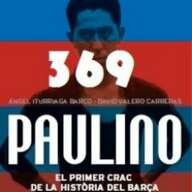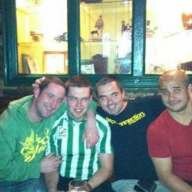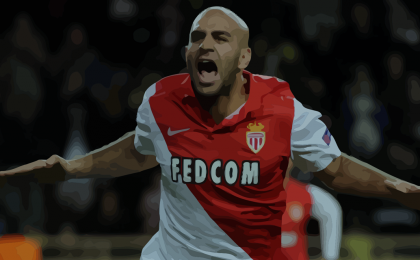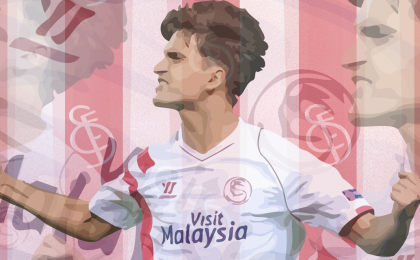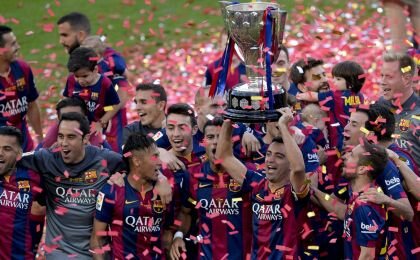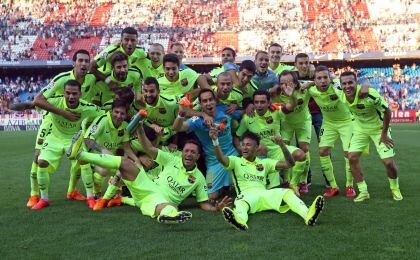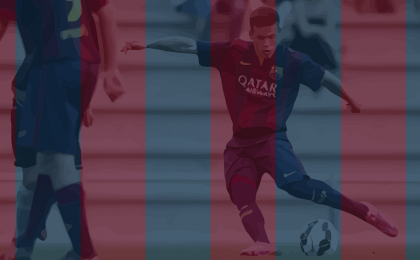 specials | 2015-07-30
specials | 2015-07-30
The Great 1984/85 La Liga Season - Part Two
A fantastic winning streak
In the middle of this atmosphere of continued disillusion and general skepticism, the 1984/85 season began, which, after everything that had happened, was perceived to be full of uncertainties. But, before long, “the bank had broken”, as the Catalans had a 3-0 victory away to Real Madrid that was as convincing as it was unexpected. It seemed like something had definitely changed.
On top of that, one of the promising youngsters, Ramon Maria Calderé, had played a memorable game with a goal and two shots hitting the post, in what was his full La Liga debut. Sadly, the television footage that remains from this historic encounter is rare and of poor quality, since it was recorded by a camera which belonged to the white team themselves.
The reason for this is that, during that season, there was a massive conflict over television rights and, apparently, the only negotiating tool that the clubs (led by José Luis Núñez) had was causing irreparable damage to all the fans of the time, and also to those of the subsequent decades. At just 12 years old, I was unable to understand the reason for such harmful behavior. Now, 30 years later, I still cannot figure it out.
The TV rights issue was not the only “political” conflict that occurred in that particularly tumultuous season. The dispute that the players’ union had with the management was covered up and led to a strike. Another conflict was motivated by the distribution of the money from the quinielas betting pools, which led to the league calendar being concealed by the Association of Clubs during the first phase of the season.
The game at the Bernabéu would not be a flash in the pan; rather, it led to a spectacular 15-game unbeaten run, with 10 victories and five draws. Yet another unusual fact from that season was that, on the second day, the aforementioned player’s strike occurred, to which the clubs responded by fielding their amateur players or, in FC Barcelona’s case, the third team, the now-defunct “Amateur” Barcelona.
The blaugranas overcame the hazard with a comfortable 4-0 win over Real Zaragoza, in a game in which a young man from La Masia could be seen on the Camp Nou pitch who, years later, would shoot to fame: Teruel’s Luis Milla, who scored a spectacular headed goal. The second match-day was not played due to the strike, and the corresponding match – away to Elche – was moved from September to November.
That clandestine Barça side, who we never saw on TV, got to the halfway point of the competition hurtling towards the title with hallmarks which were summarized in a newly-coined term which was being spread through word of mouth: “pressing”. That blueprint, designed by Venables, was characterized by an intense pressure up front, which gave rise to a dynamic playing style rarely seen on these shores.
The style of football that we had suffered through in the years immediately before were boringly conservative and dull, Venables’ Barça side, conversely, proposed something different; they offered us matches which were more intense and spectacular. The standings at the halfway point of the competition (only 34 games were played back then) could scarcely have been better: Eleven victories, five draws and one single defeat which came, of course, at San Mamés, home of the fearsome – in every sense of the word – Athletic Bilbao.
Among all of the wins in this first half of the season, the ones that particularly stood out are those earned at the Calderón against Atlético de Madrid (1-2) and the 4-2 victory at home against a Valladolid side containing “Pato” Yáñez and “Polilla” Da Silva where they overcame a 1-0 deficit which would become a 4-1 advantage shortly after the start of the second half. The 3-1 victory against Sevilla is also worth mentioning, a game in which an inspired evening from the Sevilla goalkeeper, Paco Buyo, kept the game from ending in a cricket score. The only defeat, which came at San Mamés, was by a solitary goal from the then Bilbao player, Julio Salinas.
The established starting XI at that point was made up by Urruti between the posts, Gerardo at right back (who, against all odds, had taken the position from the captain Sánchez); Julio Alberto at left back; the eternal center halves, Migueli and Alexanko; Victor and Schuster in midfield, often accompanied by Calderé; up front were Carrasco on the wing, Archibald at center forward and Rojo as playmaker. Marcos also played an important role, although it was often from the bench.
The festival came in the second half of the season. The team reached its highest level and the victories kept on coming, with apparent ease. Real Madrid fell 3-2 at the Camp Nou, Esteban scoring a wonder-goal which Messi would have been proud of, before the little genius was even born: He started out on the wing, ran towards the box bypassing defenders and finished by placing the ball in the back of the net with an expertly-placed shot which took a nick off the post.
The whole stadium erupted at the beauty and significance of the goal. The next game would become one of the greatest demonstrations of superiority of the season, but just before that, an incident occurred that made people think that bad luck had not yet completely abandoned the club.
Before the journey to the capital of the Ebro, “Lobo” Carrasco crashed his brand-new BMW into a tree and was taken to a hospital with minor injuries, although they were serious enough to prevent him traveling with the rest of the team.
Playing at La Romareda was always a difficult task, but with a resounding 4-2 victory, the team passed the test with flying colors. One of the features of the blaugrana’s season soon became clear: The ability to overcome adversities and come back in games that they were losing. On this occasion, Zaragoza had gone ahead in the seventh minute, but 15 minutes later Barça were already winning 3-1, thanks to goals from Clos, Esteban and Archibald.
At this stage of the season, the team’s confidence was such that they even won at what had historically been a bogey ground for them – El Sadar, home of Osasuna. After years of defeats, some of which were significant, the blaugrana didn’t flinch and beat the Navarra team 2-1.
The heaviest defeat of the season was that of Murcia CF, who arrived at the Camp Nou in the middle of a profound internal crisis – the players were not being paid and, as a result, were not training either – and left having been defeated 6-0. In this game, with the score already 4-0, Steve Archibald tried to score a goal straight from the kickoff, but the ball went narrowly over the bar. Another of the great rivals, Atlético de Madrid (who still counted Hugo Sánchez among their ranks) was restricted to a draw in the Camp Nou, thanks to the great Urruti, who managed to save the Mexican’s penalty, a carbon copy of what would happen a month later.
The highlight of the season – along with the win at Zaragoza – came the week after the match against Atlético. FC Barcelona visited one of the toughest grounds in the competition: Valencia’s Luis Casanova stadium. But it was here where Schuster and his teammates would paint the masterpiece of that La Liga season with a historic 5-2 victory which included a goal where the German won the ball in midfield and set off toward the opposition goals, pursued unsuccessfully by several opponents.
When he got to the box, he placed the ball beyond the reach of the goalkeeper, Sempere, without showing any signs of fatigue after a 50-meter sprint. Yet again, the opponent had gone ahead on the scoreline, on this occasion, as a result of a goal by Roberto Fernández (who would play for Barça years later), who scored in the 12th minute. But, once again, a stunning response from Barça meant that, 24 minutes later, the scoreboard read spectacularly: 1-4. This was another match that we were not able to see and which, today, should be in all video libraries. I am unaware whether only the goals have been retained, or the entire match itself.
With no televised football and with substandard highlights, the radio was more important than ever that season; you were now able to tune in to Fernández Abajo on Cadena Catalana or Joaquim Maria Puyal on Ràdio Barcelona. The transistor was an indispensable tool at a time when the internet did not exist and, much less, apps or mobile phones.
The fact is that, in order to see footage of Barça, a strange and quite popular alternative was available back then: A small production company called Video Soncosa recorded all of the matches from a spot in the stand. Later, they would edit the footage, put in sound from a prerecorded background and add some of their own distinctive commentary.
These videos were marketed under the slogan “Barça’s video-club” and they were disappearing just as the TV rights market was being consolidated. It would be another few months until I became a socio myself, so, with very few exceptions, I was unable to watch home games. My club membership (as a child) would not come until May 1985, the date I received an ID card with the number 110,681.
Have you read the first part of this series? If you haven't, read it here: The Great 1984/85 La Liga Season - Part One



